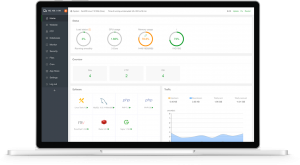This guide will walk you through How to install CyberPanel Control Panel on your server.
Requirements
- Server with a fresh install of Centos 7.x, Centos 8.x, Ubuntu 18.04 or Ubuntu 20.04
- Python 3.x
- 1024MB RAM, or higher
- 10GB Disk Space
CyberPanel vs CyberPanel Ent
CyberPanel is 100% identical in both versions. The only difference is which web server is running in the back-end.
- CyberPanel comes with OpenLiteSpeed and is completely free for an unlimited number of domains and worker processes.
- CyberPanel Ent comes with LiteSpeed Web Server Enterprise and it is free for 1 domain.
Installing CyberPanel
Step 1: Connect to your server via SSH
The installation of CyberPanel is quite simple. First, log into your server via SSH as the root user (sudo will not work). You can get the login details from your web host.
Step 2: Run the installation script
Run the following command. It will initiate the automated installation script, which will prompt you for a few decisions about which version of LiteSpeed and which add-ons you would like to install.
sh <(curl https://cyberpanel.net/install.sh || wget -O - https://cyberpanel.net/install.sh)
Step 3: Select the version of LiteSpeed that you would like to use
Select -. If you select LiteSpeed Enterprise, please ensure that you have obtained a license key first. It is free for 1 domain.
CyberPanel Installer v2.1.2 RAM check : 184/981MB (18.76%) Disk check : 7/30GB (27%) (Minimal 10GB free space) 1. Install CyberPanel with OpenLiteSpeed. 2. Install Cyberpanel with LiteSpeed Enterprise. 3. Exit. Please enter the number[1-3]:
If you selected LiteSpeed Enterprise, you will see the following prompt. Enter your serial number
If you do not have any license, you can also use trial license (if server has not used trial license before), type TRIAL Please input your serial number for LiteSpeed WebServer Enterprise:
Step 4: Select options and add-ons
You will be presented with a series of prompts for different options and add-ons that are available.
Full Service (default Y):
- PowerDNS – This is [ ]…
- Postfix – This is [ ]…
- Pure-FTPd – This is [ ]…
Remote MySQL (default N):
- This is [ ]…
CyberPanel Version (default Latest Version):
- You can choose to install a previous version of CyberPanel, or press Enter to install the latest
Password (default “1234567”):
- It is recommended that you use “s” to set your own strong password
Memcached (default Y):
- This is [ ]…
Redis (default Y):
- This is [ ]…
Watchdog (default Yes):
- This is [ ]…
Step 5: Installation
The installation process will proceed automatically. It will take 5-10 minutes, depending on the speed of your server.
Step 6: Finalize Installation
At the end of the installation process, you will be presented with the following screen which contains important information about your configuation. Select and copy it to a safe location for future reference.
################################################################### CyberPanel Successfully Installed Current Disk usage : 7/30GB (26%) Current RAM usage : 313/981MB (31.91%) Installation time : 0 hrs 11 min 0 sec Visit: https://<your server's IP address>:8090 Panel username: admin Panel password: <the password you set during installation> Visit: <your server's IP address>:7080 WebAdmin console username: admin WebAdmin console password: TSXMwny4zVeDg37K Visit: https://<your server's IP address>:8090/rainloop/?admin Rainloop Admin username: admin Rainloop Admin password: gQKFWm9O3nr7Xn Run cyberpanel help to get FAQ info Run cyberpanel upgrade to upgrade it to latest version. Run cyberpanel utility to access some handy tools . Website : https://www.cyberpanel.net Forums : https://forums.cyberpanel.net Wikipage: https://docs.cyberpanel.net Docs : https://cyberpanel.net/docs/ Enjoy your accelerated Internet by CyberPanel & OpenLiteSpeed ################################################################### If your provider has a network-level firewall Please make sure you have opened following port for both in/out: TCP: 8090 for CyberPanel TCP: 80, TCP: 443 and UDP: 443 for webserver TCP: 21 and TCP: 40110-40210 for FTP TCP: 25, TCP: 587, TCP: 465, TCP: 110, TCP: 143 and TCP: 993 for mail service TCP: 53 and UDP: 53 for DNS service Your provider seems blocked port 25 , E-mail sending may not work properly.
Step 7: Restart Server
Would you like to restart your server now? [y/N]:
Enter “y” to restart. Or enter “reboot” later after you have performed other desired operations.
Step 8: Access CyberPanel
URL: https://<Your Server's IP Address>:8090 Username: admin Password: <the password you set during installation>
Troubleshooting
503 Error After Install
systemctl status lscpd
systemctl start lscpd
2. Manually set up virtualevn
source /usr/local/CyberCP/bin/activate pip install --ignore-installed -r /usr/local/CyberCP/requirments.txt deactivate virtualenv --system-site-packages /usr/local/CyberCP systemctl restart lscpd
/var/log/installLogs.txt


